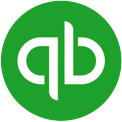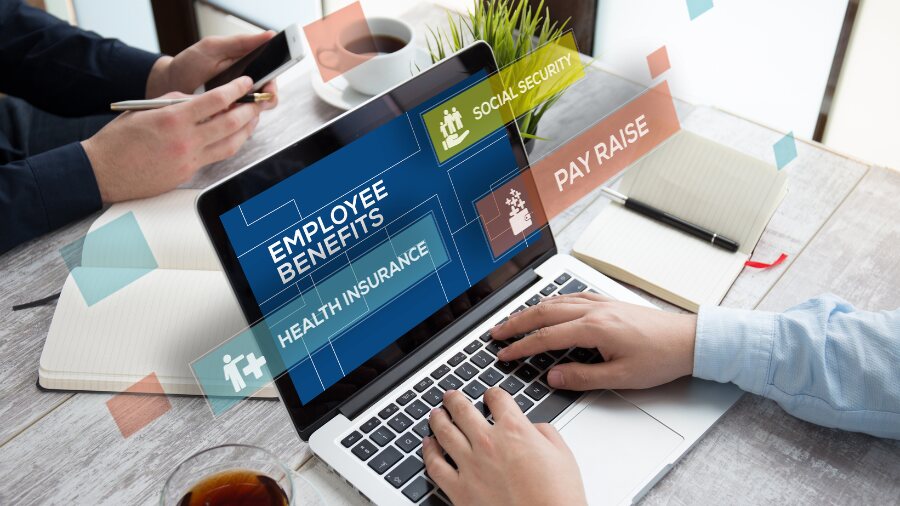As a small business owner, you want to provide your employees with a host of benefits that help you hire top talent, but you need to make money. The good news is that many of the benefits you offer employees are deductible on your tax bill. Would you rather give your money to your employees or the Canada Revenue Agency (CRA)? Whether you decide to provide your employees with business phones or let them use their own equipment, you need to know the tax and legal implications of your choices.

Employer Tax Guide: Employee Tax Implications and What to Know
Company-Provided Equipment and Services
If you want your employees to use online accounting applications, the simplest solution may be to purchase the equipment and services they need. For example, if your employee works from home, you may decide to buy them a laptop and pay for their internet service. Alternatively, if you have a remote workforce, you may provide all your employees with mobile phones. In this case, you can write off the costs as business expenses, and your employees don’t have to report anything on their tax returns.
Work and Personal Use
If your employee uses the equipment or services for personal use, the CRA may require you to report some of the associated costs as taxable benefits. The benefit is the fair market value of the product or service multiplied by the percentage of time related to personal use. To explain, imagine you pay $100 per month for your employee’s internet service. Your employee uses the service 40 percent of the time for work and 60 percent for personal use. As a result, you must report $60 per month as a taxable benefit on your employee’s pay cheque stub, and you must remit Canada Pension plan contributions, Employment Insurance premiums, and income taxes as if the benefit were cash.
Mobile Phone Service Exception
Mobile phone service is an exception to the above rule. Your employee can use a company-provided mobile phone for personal use without reporting any taxable benefits if the following conditions are met:
- The plan has a fixed cost.
- The cost is reasonable.
- Your employee’s personal use does not increase the cost of the plan.
Employee-Purchased Equipment and Services
If you require your employees to use their own equipment or services, they may be able to deduct some of those costs on their tax returns. The laws can vary based on whether your employees are salaried, work on commission or fall into another category. However, in most cases, if you require your employees to use mobile phone service for work, your employees can write off the portion of the cost that relates to work. Your employees cannot write off expenses related to connecting or licensing the mobile phone.
Your employees also cannot claim a deduction for buying their own computers or mobile phones or for paying for internet service. If you require your employees to work from home, they can claim a deduction for work use of their home. In these cases, you need to fill out Form T2200 (Declaration of Conditions of Employment) to show the CRA that your employee is obligated to incur these expenses as a condition of their jobs.
Lump Sum Payment for Terminated Employees
No one enjoys terminating an employee but you might consider softening the blow with a lump sum payment instead of allowing the employee to work out the notice. When terminating an employee, provincial and federal labour laws, as well as some individual employment contracts, dictate that you must give a notice period or a lump sum payment in lieu of a notice. The notice period varies from province to province and according to the employee’s seniority, but it usually ranges from two weeks to several months.
Often, businesses choose to pay an amount in lieu of the notice period (usually the salary earned by the terminated employee during the notice period) to avoid keeping potentially disgruntled employees within the company. After all, who wants a disgruntled employee upsetting others? If you do this, you have income tax and payroll tax consequences to consider.
Income Tax Considerations
When you pay an employee a lump-sum amount in lieu of termination notice under the terms of an employment contract or federal, provincial, or territorial employment labour standards, the amount is considered employment income. As such, you must include it on a T4 slip, and the employee must report it in their annual tax return. As with any salary, you must withhold income tax. Instead of using the usual calculation method, you must use a special method based on the payment of bonuses.
To determine how much income tax to deduct under the bonus method, take your employee’s total remuneration for the year minus union dues, pension contributions (including registered retirement savings plans), and, if applicable, the deduction for living in a prescribed zone.
After subtracting these amounts, if the total remuneration for the year, including the lump-sum payment, is $5,000 or less, deduct 15% tax (10% in Quebec) from the amount paid to the employee. If it is more than $5,000, you need to make further calculations based on the payroll deduction tables provided by the Canada Revenue Agency. The rate is different in Quebec because under the separate provincial laws, you also need to calculate source deductions and remit the amounts directly to the provincial government.
Payroll Taxes
At the federal level, you must also deduct Canada Pension Plan contributions and employment insurance premiums. To determine the amounts to deduct, you should include the wages in lieu of termination notice with the regular income, if any, for the pay period and use the CRA’s free online payroll deductions calculator. When calculating these payments, you need to be aware of the applicable annual maximum contributions to make sure you don’t go over them. Also, don’t take into account any premiums that a previous employer deducted in the same year.
Here also, the province of Quebec has a different regime. Your employees don’t contribute to the Canada Pension Plan but rather to its provincial equivalent, the Quebec Pension Plan, which also has mandatory source deductions. Calculating the various source deductions can sometimes result in the employee receiving less net wages than expected. In such cases, it’s important to understand that these source deductions are not a final tax and that your employee may be entitled to a refund when he files his annual tax returns.
Employee Benefit Packages
Your employee benefit programs help to attract quality talent to your team. The right incentives also boost employee satisfaction and retention, ultimately saving you money on recruiting, interviewing, and training costs. The best news is that as an employer, you can claim the cost of most employee benefits as a business expense, which helps lower your taxable income.
Health and Dental Plans
If you offer private health or dental services plans to your employees, you can write off the cost you pay for premiums, and your employees don’t have to pay any income taxes on the benefit. If you decide to offer mental or physical health counselling services for your employees, the CRA also allows you to claim the cost as a business expense and doesn’t require your employees to report the benefit as income.
RRSP Matching Programs
When your employees contribute to a registered retirement savings plan (RRSP), they don’t have to pay income tax on their contributions. If you decide to match contributions, you may claim the matching amount as a business expense. You must remit payroll deductions, such as Employment Insurance premiums and Canada Pension Plan premiums, on your contribution. Also, you receive similar tax benefits when you establish group plans for tax-free savings accounts or registered education savings plans.
Wage Replacement Plans
Whether you have a group wage replacement plan or a non-group plan, you can deduct the contributions you make as a business expense. If you have a group plan, your employees don’t have to report your contributions as taxable income. If your employees stop working and receive wage replacement benefits, they have to report those payments as income. On the other hand, if you have a non-group plan, your employees have to report the premiums you pay as income but don’t have to report benefits received through the plan.
Gifts
If you give your employee a cash bonus, they must pay income tax on that amount, and you must remit source deductions. You can save a bit of money by giving your employees non-cash gifts such as golf clubs, new phones, cameras, or other items. The CRA allows you to give one gift worth up to $500 to each employee per year. You may write off the value of the gift, and your employees don’t have to report it as income.
Employee Stock Options
Unfortunately, in most cases, you cannot claim a deduction for offering employee stock options, but there are exceptions in certain cases. The value of this benefit can be immeasurable for you as an employer. When you give your employees stock options, you offer them a share of profits, instantly making them personally invested in the company’s success.
If your business is a Canadian-controlled private corporation (CCPC), your employees aren’t taxed on this benefit until they sell the stocks. If your business isn’t a CCPC, your employees may have to report and pay tax on the benefit when they exercise the option to buy the shares. Then, your employees may have to report a capital gain or loss when they sell the shares.
Holiday Bonus as a Lump Sum Payment
Rewarding employees for a job well done is a great way to increase morale, but it’s important to know how to report bonuses and similar gifts during tax time to avoid penalties and fines. Unless you give the gifts during the holidays or for special occasions, the CRA always considers it income.
Under the gift tax rule, if an employee receives more than $500 in non-cash gifts in a single year, that income is taxable. Keep that in mind when you plan those extravagant catered Christmas parties, where the cost is $150 per person or more or when you take your employees out for meals at the latest gourmet restaurant.
Some gifts are always considered taxable regardless of how much they’re worth, including near-cash gifts and awards such as gift cards to a favourite retail store, travel points, or reward points to apply to a family vacation, and even gifts given by shareholders. Small, low-value items such as chocolates, T-shirts, plaques, and mugs are exceptions to the rule and don't count as income, so you can feel free to send out Godiva chocolates or company swag. Just remember that chocolate is always a welcome gift.
Other items that are exempt include the business use of a vehicle and reimbursements for travel expenses. You can reimburse an employee for mileage provided it follows the CRA guidelines for reasonable per kilometre allowance.
You may also reimburse an employee for meals and travel or offer an advance for expenses as long as they keep track of any amounts they spend and submit an expense report with receipts. Offering a small reward is an excellent way to show thanks to an employee for a job well done, but it’s important to keep track of these amounts to avoid penalties in the event of an audit.
Paid Employee Parking
As a generous employer, you probably want to provide a lot of perks and benefits to your employees, but before you give out too many perks, you should understand the CRA’s rules on these types of benefits. In particular, if you provide free parking to your employees, you may have to report the value of the parking as a taxable benefit.
Calculating the Benefit
To calculate the value of this benefit, use the fair market value of the parking spot minus any cost your employee pays. You want to use this formula even if you own the parking lot and don’t have to pay the fee. Imagine parking spots cost $20 for consumers. This amount is the fair market value of the parking spot. If your employee reimburses you $5, you report a $15 benefit to your employee.
Reporting the Benefit
You should report parking benefits annually on your employees’ T4 slips. Report the value of the benefit as explained above in box 14. Then, note code 40 in the other information section at the bottom of the slip. For example, if you assess that the parking is worth $15 per day, and your employee works 245 days during the year, you report a taxable benefit of $3,675 on your employee’s T4 slip.
The CRA requires you to withhold Canada Pension Plan contributions and income tax from this benefit. You only have to withhold employment insurance if you provide the benefit in cash to your employee.
Exceptions to the Rule
There are key exceptions to the rule requiring you to report parking as a taxable benefit to your employee. Disabled employees, in particular, don’t need to report parking as a benefit. In addition, if your business is in a mall or office park with a large free parking lot, you don’t have to report the parking as a benefit. In this case, the fair market value of the parking is nothing, so there is nothing to report.
Scramble parking exists when you have fewer parking spots than employees, and workers have to “scramble” to get a spot. Due to the uncertainty of this situation, scramble parking is also not considered a taxable benefit. It’s important not to confuse scramble parking with unassigned parking.
To explain, imagine you rent 80 spaces in a parking garage and have 80 employees. Although the employees are not assigned a spot, they get one every day, and as a result, this is a taxable benefit. In contrast, imagine you book 40 parking spots for 80 employees, and the rest of your employees have to pay for parking or find spots in the street. This is scramble parking, and it isn’t a taxable benefit.
If your employees have to use their personal vehicle for work, the parking is also not a benefit. Driving to and from work from home doesn’t constitute using your vehicle for work.
Your employee must be driving to meet clients, attend meetings or handle other work-related tasks. Parking can be essential, but if your office is in an area where parking costs money, you typically have to consider free parking as a taxable employee benefit. Of course, that’s not the only benefit you may want to offer your employees.
How to Calculate Taxable Automobile Benefits for Your Employees
If you require your employees to drive vehicles for work and they also use the vehicles for personal use, you may have to report taxable benefits on their pay checks. The Canada Revenue Agency has an online calculator, called the Automobile Benefits Online Calculator, that can help you determine the amount of these benefits.
You should prorate the benefit to employees’ pay periods, meaning you should distribute the benefit over the course of a year rather than all at once. Report an employee’s taxable benefits for an automobile, or the amount they may pay taxes on later, on a T4 slip.
Using the CRA’s Online Calculator for Taxable Automobile Benefits
To use the Automobile Benefits Online Calculator, you need the following pieces of information:
- Whether you or the employee owns the vehicle
- The province where your business is located
- The tax year
- The cost of the vehicle, including tax
- Details on employee reimbursement, if applicable
- Total kilometres driven
- Business kilometres driven
- Personal kilometres driven
You also need to note if the employee agreed to use the alternative method of calculating operating expenses. If so, you need to have that in writing. Based on that information, the calculator tells you how much of a benefit you need to include on your employee’s pay cheque for each pay period. In most cases, if you own the vehicle, you only have to report a taxable benefit if your employee uses the vehicle for personal use.
If your employee owns the vehicle, you may have to report any allowances you provide to cover business use of the vehicle as benefits. In these cases, your employees can offset that income by deducting vehicle expenses on their tax returns.
If the calculator instructs you to report a taxable benefit on your employee’s pay cheque stub, you need to withhold income tax and pay Canada Pension Plan contributions (or Quebec Pension Plan contributions) on that amount. You don’t have to pay Employment Insurance premiums, because those aren’t a cash benefit.
Standby Charges
If you provide employees with an automobile and the employee drives it for personal use, you must report the employee benefit as a standby charge as a form of income for the worker. As the employer, you receive a tax credit for allowing your employee to use the vehicle, but you must report the standby fee, along with the operating expense benefit, as income for the employee.
Rules Regarding Standby Charges
When employees only drive the car for company business and return it to your organization’s motor pool every night, you do not report any standby fee or the operating expense benefit for taxes. Employees who drive the car home at night and use it for personal business are responsible for taxes on both sources of income for their personal income taxes.
Calculating Standby Charges
The amount of the standby fee is based on several variables, so the Canada Revenue Agency provides a standby tax calculator for vehicle benefits. The amount of the standby charge may change based on the year of the vehicle, the province or territory where the driving occurs, how many kilometres the employee drives the car, and how many days the employee uses the vehicle.
Depending on the value of the vehicle and how much the employee drives it, your company car could be more of an employee liability than a benefit. You want to encourage good record keeping from employees who use a car you supply.
Therefore, you must know the number of kilometres the employee drives the company car for personal use to calculate the standby fee. If employees reimburse the company for some of the operating expenses of the vehicle, it reduces their tax liability for the income. Reimbursements from an employee for use of the car also reduce the standby charges you include in your employee’s income.
While providing an employee with a company car is often beneficial, it can increase the paperwork you must complete and file as part of the employee’s income. Allowing the employee access to the vehicle for personal use requires accurate record keeping to meet government requirements at tax time.
QuickBooks makes tracking expenses, income, and mileage logs easier. Just input kilometres in the employee’s record on the software, or add notes in the payroll portion of the program to make aggregating this information simpler, because all of the information is in one place.
Learning and mastering all the available tax deductions can be a challenge, but you can discover new ways to reward your employees and save on your tax bill at the same time. With this look at the most common tax deductions, you’re already on your way.
Make sure to track all of your expenses and keep a close eye on the types of benefits that you can deduct before calculating that yearly tax bill. QuickBooks Online can help you maximize your tax deductions. Keep more of what you earn today.




